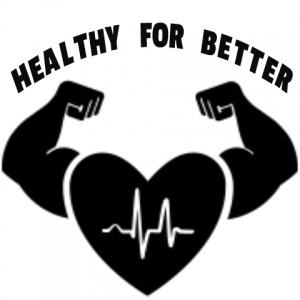Many search for a silent night, a deeper slumber far from tossing and turning. What if your own breathing could be the answer? By adding breathing techniques for better sleep to your bedtime routine, your nights could change. This could make your days better too. Let's find out how relaxation breathing techniques can make you sleep and rest better.
Adding simple breathwork to your night routine could bring the peace you want. You don’t need sleep aids. Look inside and use the power of your breath. This can bring peaceful sleep and sweet dreams. Want to learn how?
Key Takeaways
- Unlocking restful sleep through the natural power of breathing.
- Integrating relaxation breathing techniques into your bedtime routine.
- Discovering breathing exercises tailored for deeper, more restorative slumber.
- Adopting mindful habits to improve nightly rest without pharmaceutical aids.
- Exploring the transformative potential of breath for a better night's sleep.
The Prevalence of Insomnia and Its Daytime Impacts
Many people cannot sleep well because of common sleep problem called insomnia. It makes it hard to get a good sleep at night. Stress from jobs, school, money issues, and relationships are often the cause.
This lack of sleep at night affects our day too. It makes us not feel like ourselves.
Understanding Insomnia and Its Frequency
Insomnia is a big problem. It tells us something is wrong with our daily life. Even though we're tired, sleep breathing exercises might not fix everything.
Recognizing the Daytime Effects of Poor Sleep
When we don't sleep well, we feel grumpy, tired, and can't focus during the day. These feelings hurt our job and how we talk to others. It makes every part of our day hard.
Statistics on Sleep Deprivation and Health Risks
Is getting enough sleep really optional? No, it's not. Adults who don't sleep enough face worse health risks. Things like heart problems, sadness, and diabetes can happen. Each statistic tells a story of not sleeping enough. It's a call to take better care of ourselves.
We need to find better ways to sleep that help our overall health. Not just quick fixes like sleep breathing exercises.
Prescription Sleep Aids vs. Natural Remedies
Many Americans use prescription sleep aids for insomnia. But they worry about side effects and becoming dependent. Natural sleep methods are now more popular. They improve sleep without the need for drugs.
Drawbacks of Prescription Medications for Sleep
Using sleep drugs can make you depend on them. This can lead to problems. People need safer ways to sleep well.
Side effects can include feeling sleepy or dizzy during the day. There can also be serious allergic reactions. We must use these medicines carefully.
The Emergence of Natural Sleep Techniques
People want safe ways to sleep, so natural methods are gaining fans. These methods are safe and help people take control. They fit easily into daily life.
Methods like meditation and a regular sleep schedule help. So does making your bedroom just right for sleep. People find they can sleep well naturally.
We all want good sleep, so we compare prescription aids and natural methods. The aim is good sleep for everyone. This means without using drugs that can become habit-forming.
Breathing Techniques for Better Sleep
Many people find it hard to sleep well every night. They use mindful breathing for sleep as a natural way to get better rest. By doing special breathing exercises, they make a perfect environment for sleep.
These methods do more than slow your breathing. They create harmony that lets you enter a peaceful sleep. This includes techniques like the 4-7-8 method and diaphragmatic breathing. They help you fall asleep quicker and have a deeper sleep.

- 4-7-8 Breathing: A rhythmical pattern that reduces anxiety and prepares the mind for sleep.
- Diaphragmatic Breathing: Also known as “belly breathing,” it helps in relaxing the nervous system.
- Buteyko Breathing: Aims to normalize breathing volume and reduces hyperventilation.
- Box Breathing: A simple sequence that improves concentration and mental clarity.
- Alternate Nostril Breathing: Balances the body and promotes a calm mental state.
Adding these methods to your bedtime routine can change the way you sleep. They are a personal toolset for better sleep quality. If you practice them often, you'll work towards calm nights and lively mornings.
Also, mastering breathwork for better sleep gives you tools for dealing with stress. These practices are simple and free, just using your breath. By breathing deeply and with purpose, we set ourselves up for peaceful nights.
How Deep Breathing Affects the Mind and Body
Deep breathing techniques help our mind and body work together. Taking controlled breaths calms us down and is good for our health. Let's explore how this happens.
The Science Behind Deep Breathing and Relaxation
Using relaxation breathing techniques helps relax us by working on the vagus nerve. This makes the body calm down, increases melatonin, and gets us ready to sleep. It puts our body in ‘rest and digest' mode for healing and saving energy.
Physiological Benefits of Deep Breathing Techniques
Deep breathing has many health benefits. It gets more oxygen into our blood, helps our heart work better, and improves our lungs. It can also make our nervous system calm, lower stress, and help our circulation. These are the benefits we get:
| Benefit | Description |
|---|---|
| Melatonin Enhancement | Increases the hormone that regulates sleep-wake cycles, improving sleep quality. |
| Nervous System Calm | Activates the parasympathetic nervous system, reducing stress and inducing relaxation. |
| Cardiovascular Health | Improves heart rate variability and circulation, contributing to overall cardiovascular resilience. |
| Enhanced Lung Function | Deep breathing increases lung capacity and efficiency, aiding in respiratory health. |
Mastering the 4-7-8 Breathing Technique for Sleep
The 4-7-8 Breathing technique is special for those wanting to sleep better. Dr. Andrew Weil made it popular. It uses ancient Indian breathing methods for calmness. Adding the 4-7-8 Breathing to your bedtime routine helps you sleep well.
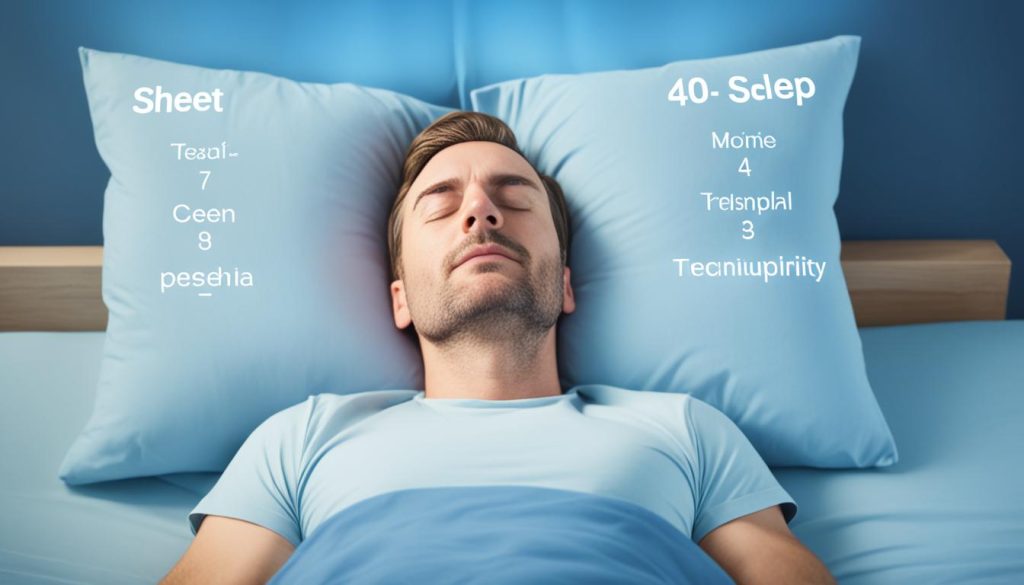
To start the 4-7-8 Breathing, get comfy sitting or lying down. Here’s a simple guide:
- Blow out all air from your lungs with a whoosh. Use your core to push all the air out.
- Close your eyes and breathe in quietly through the nose for four counts. This helps you focus inside.
- Hold your breath for seven counts. This lets oxygen fill your blood.
- Breathe out slowly through the mouth for eight counts, whooshing out stress.
Doing this four times before bed every night is important. It tells your body it's time to relax. Stick with it, and it becomes a powerful bedtime signal.
“Practicing the 4-7-8 Breathing Technique can change your body from stressed to relaxed,” says Dr. Andrew Weil.
4-7-8 Breathing helps you sleep not just in theory. It really works by slowing your heart and clearing your mind. Over time, your body learns to follow this pattern naturally at night.
Nowadays, beating insomnia is crucial. The 4-7-8 Breathing is an easy and effective way to do it. It helps you find peace before sleep, improving your health and calming you at night.
Diaphragmatic Breathing: A Core Technique for Tranquility
Want to relax and get ready for good sleep? Try diaphragmatic breathing. It's also called belly breathing or abdominal breathing. It uses a big muscle for breathing to help you take deep breaths. This is different from short breaths that happen when you're stressed.
Diaphragmatic breathing is not just for a moment's rest. It's a full approach for calmness that can make your life better. Use it daily, especially before bed. You'll sleep better and feel more at peace.
Central to mastering the art of diaphragmatic breathing is understanding its simple yet profound rhythmic motion, akin to the ebb and flow of ocean waves gently reaching the shore.
Here's how to do diaphragmatic breathing in your daily routine, especially before sleeping.
- Find a comfortable spot to lie flat on your back, with knees slightly bent or a pillow beneath your knees for support.
- Place one hand on your chest and the other on your abdomen to monitor your breathing patterns.
- Breathe in slowly through your nose, allowing your belly to rise as much as possible without moving your chest.
- Exhale through pursed lips, engaging your abdominal muscles to push all the air out.
- Repeat this cycle, focusing on the sensation of your abdomen rising and falling with each breath.
Check out this table that compares shallow breathing with diaphragmatic breathing. It shows why diaphragmatic breathing is better.
| Breathing Technique | Physiological Impact | Benefits |
|---|---|---|
| Chest Breathing | Rapid, shallow breaths | Quick oxygen intake, often during stress |
| Diaphragmatic Breathing | Deep, full breaths | Calms nervous system, promotes relaxation |
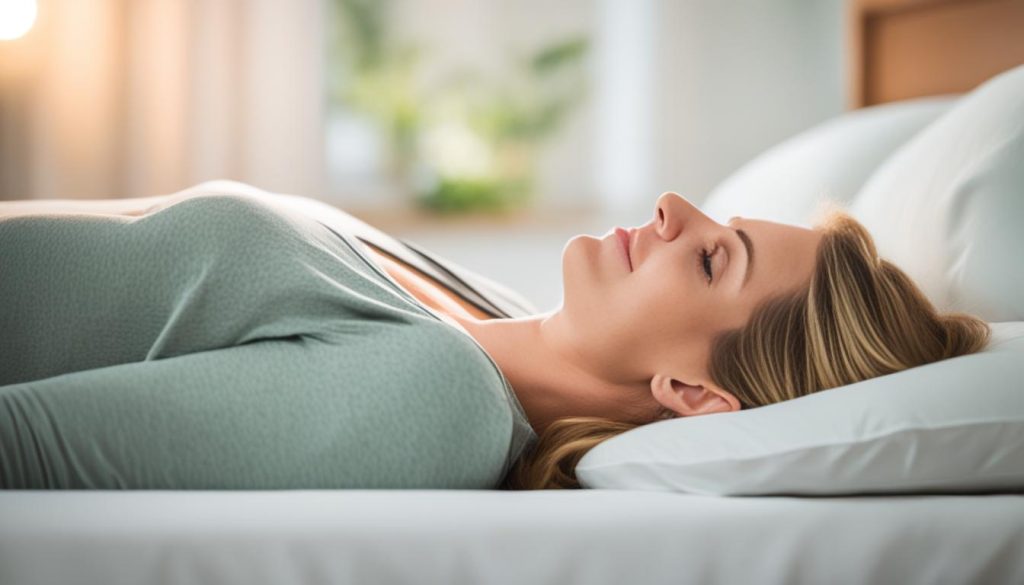
As you learn about relaxation breathing, let diaphragmatic breathing be your main tool. Deep breaths help your body relax. They help you find peace and sleep well each night.
The Calming Effects of Buteyko Breathing Technique
The Buteyko Breathing Technique was made by Dr. Konstantin Buteyko. It shows how breath control can bring inner peace. It's not just an exercise but a way to sleep better by matching your natural breathing.

People who use the Buteyko method feel calm. It helps the body get ready for sleep and lowers stress. It does this through slow breathing from the nose and small breaks in breathing. These help make your breathing regular and stop you from breathing too fast. This makes the Buteyko method a great way to fall asleep naturally.
So, how does it help you fall asleep? Here's a simple bedtime routine:
- Find a quiet, comfortable place to sit or lie down.
- Start by breathing softly through your nose. The breath should be quiet and gentle.
- Pause for a bit after breathing out, before you breathe in again.
- Your breathing should become slower and not as deep. Focus on feeling relaxed more than taking deep breaths.
- Keep doing this for five to ten minutes. Let yourself feel calm all over.
Using the Buteyko Breathing Technique at night is more than sleep prep. It's a way to control your breathing to help your wellbeing. Less hyperventilation means your body is more ready to rest. This makes it important for anyone who wants to sleep better naturally.
Box Breathing: Simplicity for Stress Relief
In our busy lives, it’s hard to find a quiet moment. The Box Breathing method, or square breathing, is simple. It's a great bedtime breathing exercise for a calm start to sleep.
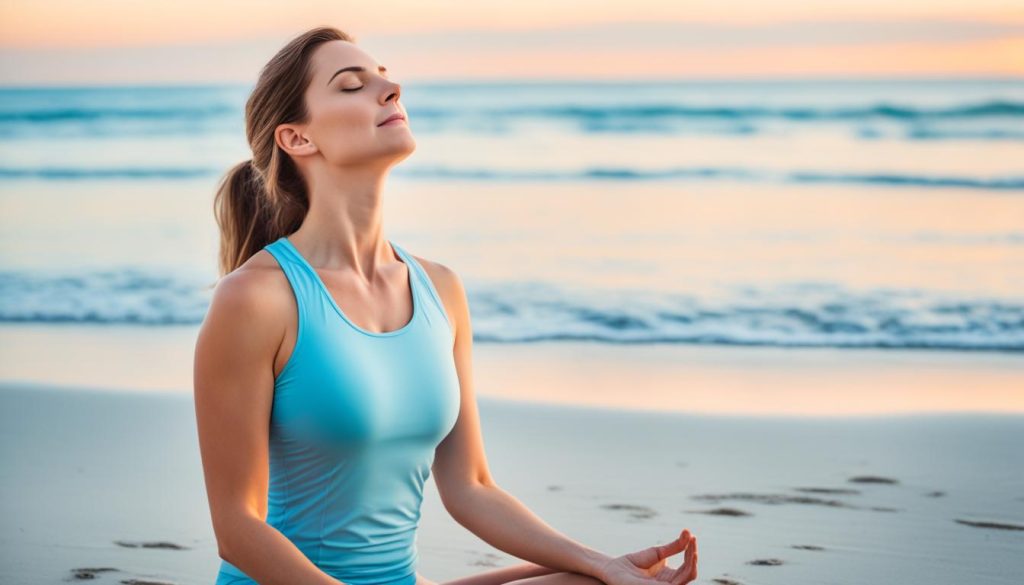
Step-by-Step Guide to Box Breathing
Box Breathing has four easy steps. You inhale, hold it, exhale, and pause. Each step takes as long as the others. This helps control your breath and calms your mind. Let's start:
- Inhale: Breathe in slowly through your nose, counting to four.
- Hold: Don’t breathe out yet, hold your breath for a count of four.
- Exhale: Now, breathe out slowly through your mouth for four seconds.
- Pause: Wait for another four seconds before you breathe in again.
Do this for four minutes or until you feel less stressed and sleepy.
Integrating Box Breathing into Your Sleep Routine
Want better sleep? Try Box Breathing every night. It eases stress and helps you relax before bed. Spend a few minutes on this exercise, away from distractions. Doing it every night gets your body ready for sleep.
Trying to relax after a busy day? Or calming your mind before sleep? Box Breathing helps. It brings peace and prepares you for deep sleep.
Alternate Nostril Breathing: A Yoga-Inspired Method
Alternate Nostril Breathing is a big deal in yoga. It makes your mind and body feel good. It does this by balancing your breathing, which is great for sleep. This method is part of pranayama. Pranayama is about controlling your breathing to improve your life force.
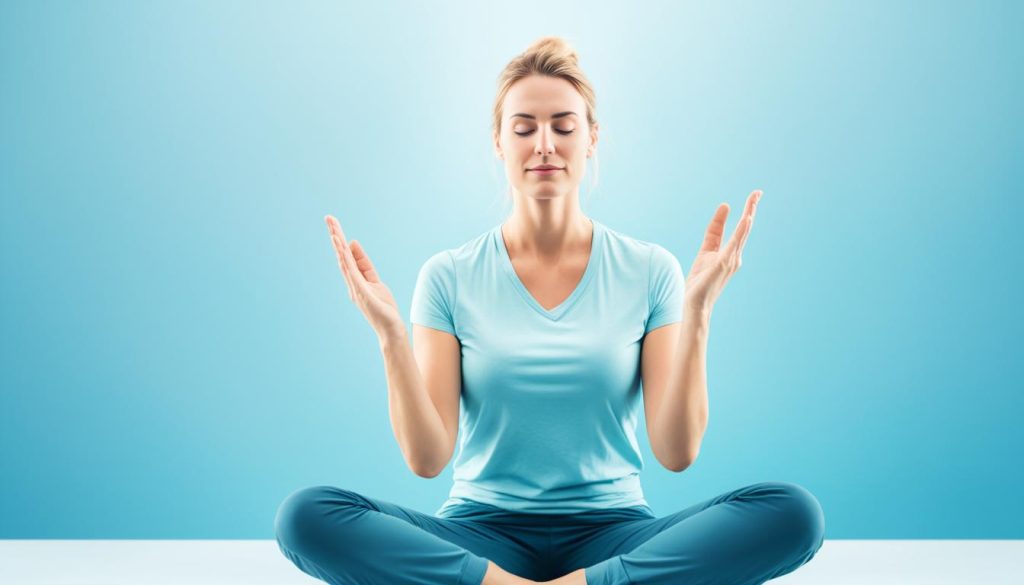
This practice is like going on a journey where you breathe through each nostril one by one. This balance helps you relax deeply and sleep better. It does more than just help your body. It calms your mind in our busy world too.
If you want better sleep, try breathwork for better sleep like Alternate Nostril Breathing. It's not just any exercise. It's a peaceful way of breathing that helps you sleep well. It's backed by years of yoga knowledge.
- Find a comfortable seated position and relax your body.
- Close your right nostril with your thumb and inhale slowly through the left.
- At the peak of inhalation, close your left nostril with your ring finger and release the right nostril to exhale.
- Inhale through the right nostril, then switch to exhale through the left.
This method is great for both yoga breathing and as an active meditation. It helps clear your mind. This makes it easier to rest peacefully.
Conclusion
In our quest for restful nights, breathing techniques for better sleep are key. They offer a way to be mindful and honor our body's wisdom. By using the power of our breath, we can fight sleep problems.
These methods help us develop healthy sleep habits. They aren't just quick fixes. They make us change our lifestyle, with a nightly breathing for relaxation ritual. This helps our mind and body get ready for deep sleep. Methods like diaphragmatic breathing, the Buteyko method, and alternate nostril breathing are helpful.
As we end our journey, remember these therapeutic sleep practices are like a comforting hand. They use mindfulness and control to help us sleep better. At night, we find peace and simplicity in our breath. It's a natural tool for peace, just like sleep.
